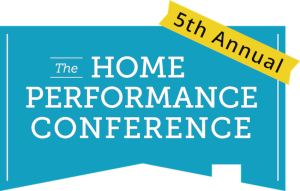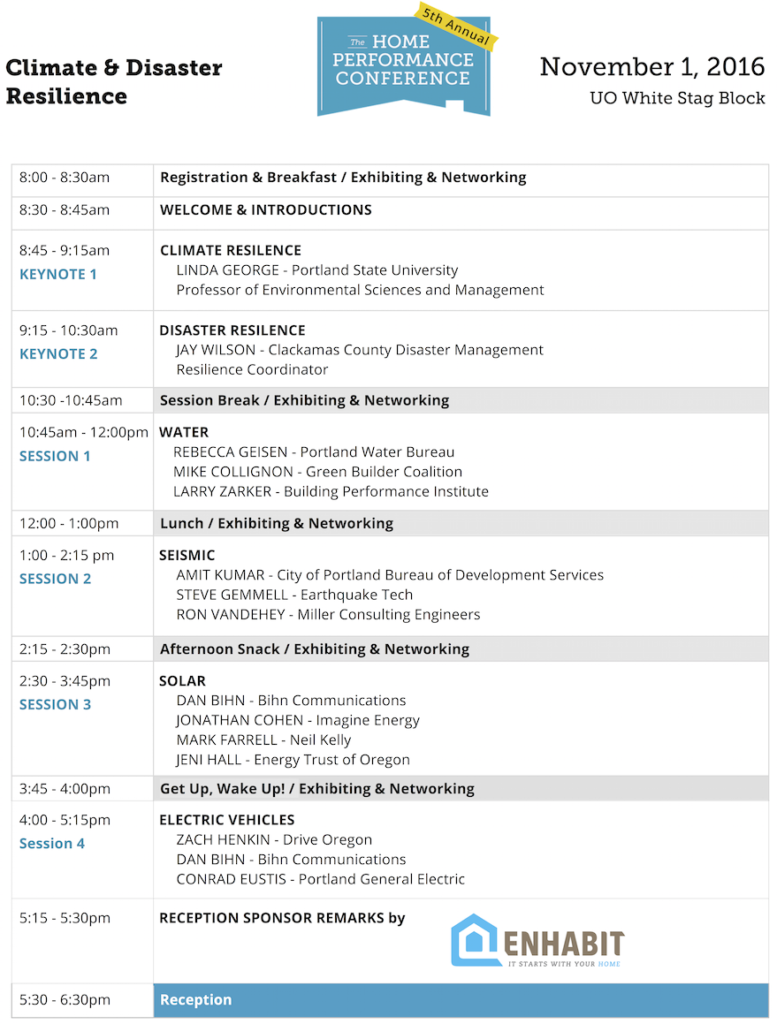SEE YOU TOMORROW!
Tuesday, November 1st – 8am to 6pm
REGISTER HERE
– – –
GUEST DISCOUNT CODE: specialguest
Member Price: $90 // Guest Price: $130 // Full Price: $180
ON SITE REGISTRATION: You can also register at the door. We take credit cards, but checks are easiest & fastest.
PLEASE NOTE:
- ADDRESS: 70 NW Couch St, Portland, OR, 97209
- REGISTRATION: desk opens @ 8am
- BREAKFAST & COFEE: will be served
- CONFERENCE START: keynote starts @ 8:30am
- TRANSIT: Old Town/Chinatown MAX Station 1 block away
- CLOSEST PARKING GARAGE: Central Parking, 33 NW Davis St, Portland, OR 97209
- BPI & CCB CEUs: Sessions are eligible for up to 6.5 CEU’s
Join us tomorrow at the 5th Annual Home Performance Conference of Oregon for an exploration of residential Climate & Disaster Resilience.
AGENDA DESIGNED TO BE APPLICABLE TO YOU!
Every agenda item, every speaker and every presentation has been sculpted into something that can either be applied by you in the field today, or that can be used to shape your near term business plans.
WHO SHOULD ATTEND?
The conference attracts Home Performance contractors, install technicians, and sales people, as well as their sub contractors (insulation, windows, HVAC, solar, seismic, etc.). It also attracts many others from the broader Home Performance industry including equipment and materials manufacturers and distributors, utility programs & implementers, CAP agencies and low-income weatherization programs, lenders, as well as anyone interested in the resilience of our built environment.
YOU DON’T WANT TO MISS THIS CONFERENCE
PRESENTER INFO HERE
CLIMATE RESILIENCE
Linda George, Portland State University Professor of Environmental Sciences and Management, is a widely published expert on: atmospheric chemistry; monitoring and modeling of urban air pollutants; assessing human exposure to and perception of air pollutants and climate change; investigations of urban climate modification; as well as atmospheric science education. During this keynote presentation titled, Making $ense and Doing Good: Retrofitting for Climate Resilience, Professor George will lay out what’s expected in terms of the effects of near- and long-term regional climate change, and she’ll shed light on the psychology of how people perceive threats and what they are willing to do in response. In so doing she’ll attempt to answer the big question of how do you get people to invest in climate resilient upgrades.
DISASTER RESILIENCE
Guiding homeowners to invest in resilience upgrades and preparedness, can often feel like trying to leverage their worst case scenario. Regardless of how those kitchen table discussions may feel, as a community that strives for resilience, it is essential that we get people engaged and talking about this. But there are so many other things at play here. Water and food security. Quality of life. Energy and transportation. We’re making decisions everyday and if resilience isn’t the lens were looking at things through, then we’re not making anything better for our kids. It comes back to the values and beliefs of the community, and their sense of place and belonging. This is the kind of thing that you don’t appreciate till its broken, at which point you have to work multiple times harder just to get back to what you had. Leaning into resilience is just being responsible as a resident of a place. During this keynote session, Jay Wilson will share is extensive experience in Disaster Resilience to establish a framework for our day-long discussion on the role of water, seismic upgrades, solar electric inverters, and electric vehicles in establishing a resilient home and community for our customers. In addition to being Hazard Mitigation Coordinator for Clackamas County Emergency Management and the Vice Chair of the 2012-2013 Oregon Seismic Safety Policy Advisory Commission (OSSPAC) which developed The Oregon Resilience Plan, Jay is also Chair of the Oregon Seismic Safety Policy Advisory Commission (OSSPAC), and a Disaster Resilience Fellow with the National Institute of Standards and Technology (NIST).
WATER
In our first panel discussion of the day, we’ll learn about many of the vulnerabilities of our water infrastructure, we’ll dig into a host of home water resilience solutions, and we’ll be introduced to the Water Efficiency Rating Score (WERS), as employed in Santa Fe, and an increasing number jurisdictions around the country. The panel will start with Rebecca Geisen, Water Resources Planning Manager with the Portland Water Bureau, who will speak to the region’s long term water planning efforts to prepare for an earthquake and the work that Portland does as it uniquely relates to climate change adaptation. Then we’ll hear from Mike Collignon, Executive Director of the Green Builder Coalition, who will speak to his experience with the WERS and its potential to enhance water resilience in Oregon. And Larry Zarker will speak to the interest of the Building Performance Institute (BPI) in establishing a nationally standardized rating for residential water efficiency for use by the Home Performance industry.
SEISMIC
In February 2011, Christchurch, New Zealand was struck by a magnitude 6.3 earthquake, killing 185 people and destroying or damaging around 170,000 buildings. In March 2011, the magnitude-9.0 Tohoku earthquake and subsequent tsunami killed more than eighteen thousand people, devastated northeast Japan, triggered the meltdown at the Fukushima power plant, and cost an estimated two hundred and twenty billion dollars. In 2015, the New Yorker printed an article called The Really Big One, that introduced many northwest residents to the hazards of living next to the Cascadia subduction zone. In the wake of those horrific events, the article set off a rush for seismic retrofits that has yet to subside. During this session we’ll hear from Amit Kumar, Sr Structural Engineer with the City Of Portland’s Bureau of Development Services, who’ll talk start with a presentation on permitting and local FEMA programs. Steve Gemmell, owner and operator of Earthquake Tech, will then follow with an outline of his experience as a seismic retrofitter, he will reflect on the evolution of tech through the years and he will share his experience navigating prescriptive and custom solutions. The session’s final speaker will be Ron Vandehey, Principal at Miller Consulting Engineers, who will outline his experience in developing custom seismic solutions for residential homes.
SOLAR
The “Cascadia Event” earthquake threatens an extended loss of the electric grid, but many owners of solar electric systems (PV) do not know (or have forgotten) that most solar PV inverters will shut down if the grid goes down. Dan Bihn sets the stage for this conversation by asking why we need disaster resilient solar and the ways in which your customers with solar may not have it. Then he’ll lay out the story of Japan, Japanese Home Energy Management Systems, and the internet of things. Jonathan Cohen of ImagineEnergy will provide a brief overview of disaster resilient solar hot water options. Jeni Hall from Energy Trust of Oregon will then talk about Solar+Storage – where the technology was, where it is and where it’s going. Jonathan andMark Farrell of Neil Kelly will close with a discussion about current options for resilient PV system design in Oregon.
ELECTRIC VEHICLES
For our final session, Zach Henkin from Drive Oregon will lead an exploration of how the home performance community can help their customers prepare their homes for EV systems that are a supportive component of their resilience plan. He’ll touch not just on how electric vehicles have arrived as a reasonable and achievable option for most homeowners, but also how an electric car can work with the energy systems of a home. And Dan Bihn will return to discuss: options for Vehicle to Home emergency power systems; how they are being integrated throughout Japan with Home Energy Management Systems, PV systems and batteries; and, what we can expect from Vehicle to Home emergency power systems here in the Northwest. Lastly, Conrad Eustisfrom Portland General Electric (PGE) will bring a utility perspective to the discussion with a presentation on a PGE pilot of a Nissan Leaf charger with Vehicle-to-Grid (V2G) capability, along with some other related PGE pilots.


